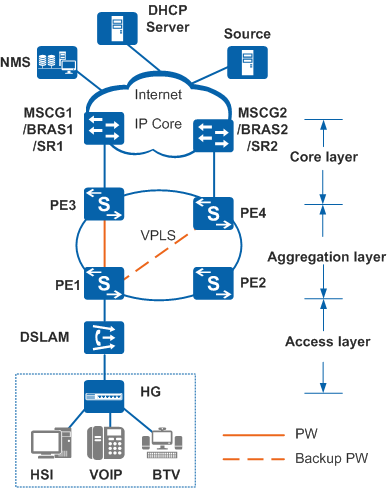VPLS Application in Individual Services
Service Overview
Individual services such as high speed Internet (HSI), voice over IP (VoIP), and broadband TV (BTV) are usually carried over carriers' metropolitan area networks (MANs).
Broadband Remote Access Servers (BRASs) or Service Routers (SRs) are deployed at the egress of the MAN as individual service gateways. Layer 2 packets from a user need to be transparently transmitted to a service gateway using VPLS or VLL technology. User information will be lost if Layer 2 packets are terminated on a PE and forwarded using Layer 3 routing. The service gateway fails to control the user because it does not have the user information. When the primary and secondary service gateways are deployed on the MAN, user traffic needs to be dual-homed to the access service gateways. VPLS technology must be used to achieve this goal.
Networking Description
Individual services are transmitted to the Internet over the access layer, convergence layer, and core layer of a MAN. Figure 1 shows a typical example implementation for individual services.
HSI services access the Internet over the MAN.
VoIP services request IP addresses from the Dynamic Host Configuration Protocol (DHCP) server over the MAN.
BTV multicast members apply for BTV services from multicast sources over the MAN.
Feature Deployment
VPLS is configured on PEs to transparently transmit traffic between them. Figure 1 uses LDP VPLS as an example to show VPLS configuration:
Access-layer devices
VLANs are configured to differentiate different types of users.
PPPoE over AAL5 (PPPoEoA) and PPP over AAL5 (PPPoA) are configured to allow access of HSI users through dialup.
Multicast VLAN and IGMP snooping are configured to transmit multicast services.
Aggregation-layer devices
Interior Gateway Protocols (IGPs) are configured on PEs so that they can communicate with each other.
Basic MPLS functions are configured on PEs so that these PEs can establish remote LDP sessions.
MPLS L2VPN and VSIs are configured on PEs.
A VPLS daisy chain is deployed on PEs to transmit multicast services.
Core-layer devices
Authentication and accounting features are configured on BRASs so that they can terminate HSI services.
IGPs are configured on SRs so that they can communicate with each other.
Basic MPLS functions are configured on SRs.
DHCP relay is configured on SRs, allowing VoIP users to obtain IP addresses from DHCP servers.
Layer 3 multicast features are configured on SRs so that these SRs can communicate with multicast sources.
